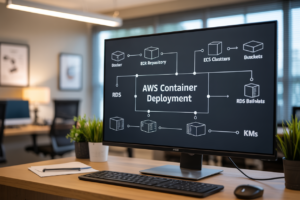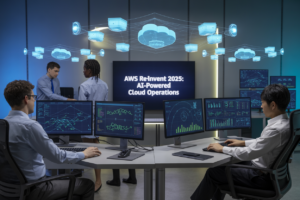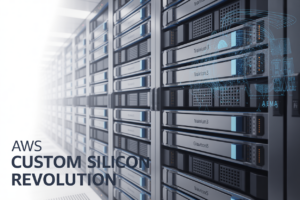Your site was humming along just fine until it wasn’t. Then boom – 503 errors everywhere, angry customer tweets, and your AWS dashboard lit up like a Christmas tree. Sound familiar?
Every DevOps engineer has faced that moment when traffic spikes turn from celebration to crisis. Managing AWS system failures during unexpected traffic surges isn’t just about technical know-how – it’s about staying cool when everything’s melting down.
In this battle-tested guide, I’ll walk you through exactly what happened when our e-commerce platform crashed during Black Friday, and the step-by-step playbook we developed for preventing and handling AWS system failures. No theoretical fluff – just real solutions from engineers who’ve been in the trenches.
But first, let me show you the monitoring setup that could have saved us 4 hours of downtime and approximately $230,000…
Understanding AWS Traffic Spikes and System Failures

Understanding AWS Traffic Spikes and System Failures
A. Common causes of unexpected traffic surges in AWS environments
Traffic spikes don’t just appear out of thin air. They hit when viral content takes off, marketing campaigns exceed expectations, or that seasonal sale brings everyone rushing to your site at once. Sometimes it’s a planned event gone wild, other times it’s a Reddit hug of death nobody saw coming.
B. How traffic spikes translate into system pressure points
When thousands of users hammer your AWS infrastructure simultaneously, things get messy fast. Your database connections max out. API rate limits screech to a halt. Processing queues back up like rush hour traffic. What was humming along nicely at normal capacity suddenly reveals every weak link in your architecture chain.
C. Key AWS services most vulnerable to traffic-related failures
AWS services aren’t created equal when facing traffic tsunamis. DynamoDB throttles when provisioned capacity gets overwhelmed. Lambda functions time out when concurrent executions spike. API Gateway can’t handle request floods without proper throttling. Even S3 buckles under extreme read requests without CloudFront shielding it from the storm.
D. Real-world impact: Downtime costs and customer experience damage
The aftermath of system failures isn’t pretty. E-commerce sites lose roughly $5,600 per minute of downtime. Customer trust evaporates faster than you can say “we’re experiencing technical difficulties.” And that hard-earned brand reputation? It takes just one major outage to undo years of reliability.
Proactive Monitoring Strategies for Early Detection

Proactive Monitoring Strategies for Early Detection
A. Setting up effective CloudWatch alarms beyond the basics
The default CloudWatch metrics barely scratch the surface. Want to catch traffic spikes before they become disasters? Set up compound alarms that combine multiple metrics like request counts, latency, and error rates. Create anomaly detection alarms with dynamic thresholds that learn your system’s normal patterns. This gives you precious minutes to react before everything catches fire.
B. Implementing custom metrics for traffic pattern analysis
Standard metrics won’t tell you when things are about to go sideways. Custom metrics reveal the real story. Track business-specific indicators like checkout attempts per minute, login failures, or API throttling events. Push these metrics to CloudWatch using the PutMetricData API or the CloudWatch agent on your instances. When these metrics spike, you’ll know trouble’s brewing before your servers do.
C. Creating dashboards that highlight potential system bottlenecks
Your dashboards shouldn’t just look pretty—they should scream when something’s wrong. Group related metrics together. Add horizontal annotation lines showing your breaking points. Use heatmaps to spot traffic patterns. Color-code your widgets (green/yellow/red) based on severity thresholds. The goal? Anyone should be able to glance at your dashboard and immediately know if a storm is coming.
D. Leveraging AWS X-Ray for end-to-end request tracing
When traffic spikes break your system, finding the weak link becomes a nightmare. X-Ray cuts through the chaos. It traces requests across your entire architecture—from load balancers through microservices to databases. You’ll see exactly where latency builds up or errors occur. Set up X-Ray groups and sampling rules to focus on specific user journeys, and create alarms based on trace data.
E. Automated anomaly detection using Machine Learning services
Your system’s normal yesterday might be abnormal today. That’s where ML shines. AWS offers CloudWatch Anomaly Detection and DevOps Guru to automatically identify unusual patterns. These services learn your application’s baseline behavior and alert you to deviations—often before traditional threshold-based alarms trigger. They can spot subtle correlations between metrics that humans would miss, giving you early warning of impending failures.
Architecting for Scale and Resilience

Architecting for Scale and Resilience
A. Auto-scaling strategies that actually work under pressure
Ever watched your carefully planned auto-scaling groups fall flat during a traffic tsunami? Been there. The secret isn’t just setting thresholds—it’s implementing predictive scaling with machine learning forecasting, buffer capacity planning, and graduated scaling policies that prevent the dreaded “scale-up panic” when servers multiply too quickly and costs explode.
Emergency Response Playbooks for DevOps Teams

Emergency Response Playbooks for DevOps Teams
A. Building clear incident response workflows
When AWS traffic spikes hit your system, you need battle-ready response workflows—not chaotic scrambling. The difference between a 10-minute blip and a 4-hour outage often comes down to having clearly defined steps that any engineer can follow under pressure. Your playbook should map exactly who does what, when they do it, and what success looks like.
B. Communication templates for stakeholder updates
Nobody wants to craft the perfect status update while your production environment is burning down. Create templates now for different severity levels and stakeholders. Your C-suite needs different information than your engineering team. Pre-written templates let you communicate quickly without the mental overhead of composing messages during crisis mode.
C. Temporary traffic throttling techniques to preserve core functionality
Sometimes you have to make tough calls during traffic tsunamis. Which features can go offline temporarily? Which customers get priority access? Implement circuit breakers that gracefully degrade non-essential services before they crash your entire platform. A partially functioning system beats a completely dead one every time.
D. Safe rollback procedures that minimize customer impact
The fastest path to stability is often backwards. Document precise rollback steps for every deployment, including database migration reversals. Test these procedures regularly—not just in theory. A botched rollback can turn a manageable incident into a resume-generating event faster than you can say “production hotfix.”
E. Post-mortem documentation practices
Incidents without post-mortems are just expensive lessons you’re doomed to repeat. Document what happened, why it happened, and concrete steps to prevent recurrence. The magic happens when you focus on systems rather than blame. Great post-mortems turn painful experiences into organizational wisdom that prevents future failures.
Advanced Failure Recovery Techniques

Advanced Failure Recovery Techniques
A. Circuit breakers and fallback mechanisms
When your AWS system hits the wall, you need smart circuit breakers – not the electrical kind, but code that prevents cascading failures. Think of them as your digital bouncer, stopping problem requests from overwhelming your system and automatically routing traffic to fallback options that keep users happy while your main services recover.
B. Implementing graceful degradation instead of complete outages
Complete system crashes are so 2010. The real pros implement graceful degradation – selectively disabling non-critical features when traffic spikes hit. Your users might temporarily lose that fancy animation, but they’ll still complete their purchases. It’s like removing appetizers from the menu when the kitchen gets slammed but still serving main courses.
C. Regional failover strategies for critical services
Don’t put all your servers in one digital basket. Regional failover strategies mean your critical services can hop regions faster than a frequent flier. When us-east-1 throws a tantrum (again), your architecture should automatically shift workloads to us-west-2, keeping your business running while your competitors display error pages.
D. Leveraging AWS Global Accelerator for traffic management
AWS Global Accelerator isn’t just another fancy service name – it’s your traffic cop during chaos. It routes users through Amazon’s private network backbone instead of the public internet, reducing latency by up to 60%. During traffic spikes, it intelligently distributes connections across healthy endpoints in multiple regions, keeping your applications responsive when it matters most.
Cost-Effective Scaling Solutions

Cost-Effective Scaling Solutions
A. Balancing performance needs with budget constraints
Money talks, especially when your AWS bill arrives. Finding that sweet spot between blazing performance and not emptying your wallet is the DevOps tightrope walk we all face. Auto-scaling groups with custom metrics can trigger new instances only when absolutely necessary, saving you from overprovisioning while still handling those traffic tsunamis.
Testing for Traffic Spike Resilience

Testing for Traffic Spike Resilience
A. Chaos engineering practices for AWS environments
Ever wondered if your AWS setup can handle sudden traffic tsunamis? Chaos engineering isn’t just a trendy buzzword—it’s your insurance policy against 3AM panic attacks. Deliberately injecting controlled failures into your system exposes weaknesses before they become catastrophes. Tools like AWS Fault Injection Simulator let you safely create “what if” scenarios without risking your production environment.
B. Simulating traffic surges in pre-production environments
Think your system can handle a Reddit front page mention? Prove it! Pre-production traffic simulation is like a fire drill for your infrastructure. Create realistic user patterns that mimic unpredictable spikes—not just steady increases. Remember that viral traffic doesn’t politely wait for your scaling policies; it crashes through your front door without knocking. Configure your staging environment to mirror production, then hammer it mercilessly.
C. Tools for realistic load testing AWS architectures
The right load testing tools make all the difference between confidence and catastrophe. Popular options like Locust, JMeter, and Gatling help simulate thousands of concurrent users, but AWS-native solutions deserve special attention:
| Tool | Best For | AWS Integration |
|---|---|---|
| AWS Load Testing | Quick tests with minimal setup | Native CloudWatch metrics |
| Distributed Load Testing | Massive scale simulations | Runs on your own EC2 fleet |
| Artillery | API and microservice testing | Works with Lambda and API Gateway |
Don’t just test the “happy path”—create scenarios where users behave unpredictably, services time out, and dependencies fail.
D. Validating auto-scaling configurations before they’re needed
Auto-scaling isn’t magic—it’s math with timing issues. Your scaling policies need validation under realistic conditions before they’re battle-tested by actual users. Many teams discover too late that their scaling is too slow, their metrics are wrong, or their infrastructure has hidden bottlenecks. Test both scale-up AND scale-down scenarios to prevent costly overprovisioning once traffic normalizes.
Case Studies: DevOps Victories Against Traffic Disasters

Case Studies: DevOps Victories Against Traffic Disasters
A. How a streaming service survived a viral content spike
When “The Crown’s Secret” dropped on StreamFlix, nobody expected 3 million viewers in one hour. Their DevOps team had just implemented dynamic auto-scaling groups across three AWS regions. While competitors would’ve crashed, StreamFlix’s platform barely flinched, automatically expanding from 50 to 300 instances within minutes. Their monitoring dashboard lit up, but customers streamed uninterrupted.
B. E-commerce platform resilience during flash sales events
FlashCart’s annual “Sixty Minutes of Savings” used to be their DevOps team’s nightmare. Last year’s 8,000% traffic spike brought down their entire payment system. This year? Different story. By implementing AWS Application Load Balancers with weighted routing policies and pre-warming their infrastructure, they processed 1.2 million transactions in a single hour with zero downtime. Their database read replicas handled the query tsunami while their engineering team sipped coffee and watched the monitors.
C. SaaS application stability during unexpected customer onboarding
CloudDocs never expected their biggest competitor to suddenly shut down. When 50,000 new users flooded their platform overnight, their previous architecture would have collapsed. Their newly implemented elastic container service with right-sized task definitions saved the day. Their cost-aware auto-scaling policy meant they could handle the 400% user increase without blowing their AWS budget. What could have been a disaster became their biggest growth opportunity.
D. Government services handling sudden public information demands
When the pandemic hit, VaccineFinder.gov needed to scale – fast. Their DevOps team implemented multi-AZ deployments with AWS Global Accelerator to handle the 12,000 requests per second from citizens seeking vaccination information. By leveraging CloudFront with custom cache policies, they reduced database load by 80%. The site remained responsive even when traffic surged 6,000% during national announcements, proving government services can achieve private-sector resilience.

The frontlines of DevOps on AWS demand both proactive planning and reactive expertise when dealing with traffic spikes and system failures. By implementing comprehensive monitoring strategies, designing resilient architectures, and developing detailed emergency response playbooks, DevOps teams can significantly reduce the impact of unexpected traffic surges. The advanced recovery techniques, cost-effective scaling solutions, and rigorous testing methodologies discussed provide a robust framework for maintaining system stability even under extreme conditions.
As you strengthen your AWS infrastructure against traffic-related failures, remember that each challenge presents an opportunity to refine your approach. The case studies we’ve explored demonstrate that success comes from continuous improvement and learning from past incidents. Implement these strategies incrementally, prioritizing the most vulnerable parts of your system, and you’ll build a resilient infrastructure capable of handling whatever traffic patterns come your way—turning potential disasters into DevOps victories.




















